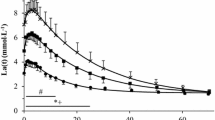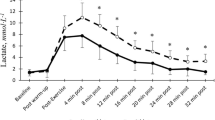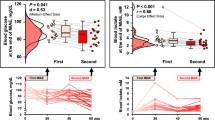Abstract
The relationships between anaerobic glycolysis and average velocity (ν) sustained during sprint running were studied in 12 national level male sprinters. A blood sample was obtained within 3 min of the completion of semi-finals and finals in the 100-m and 200-m Cameroon national championships and blood lactate concentration ([la−]b) was measured. The 35-m times were video-recorded. The 100-m and 200-m [la−]b were 8.5 (SD 0.8) and 10.3 (SD 0.8) mmol·l−1, respectively. These were not correlated with the performances. Over 200 m [la−]b was correlated with the ν sustained over the last 165 m (r=0.65,P<0.05). In the 9 athletes who participated in both the 100-m and 200-m races, the difference between the [la−]b measured at the end of the two races was negatively correlated to the difference in v sustained over the two races (r=0.76,P>0.02). Energy expenditure during sprint running was estimated from the [la−]b values. This estimate was mainly based on the assumption that a 1 mmol·l−1 increase in [la−]b corresponds to the energy produced by the utilization of 3.30 ml O2·kg−1. The energy cost of running was estimated at 0.275 (SD 0.02) ml O2·kg−1·m−1 over 200-m and 0.433 (SD 0.03) ml O2·kg−1·m−1 over 100-m races. These results would suggest that at the velocities studied anaerobic glycolysis contributes to at least 55% of the energy expenditure related to sprint running. However, the influence of both mechanical factors and the contribution of other energy processes obscure the relationship between [la−]b and performance.
Similar content being viewed by others
References
Bernús G, González de Suso J, Alonso J, Martin PA, Prat JA, Ards C (1993)31P-MRS of quadriceps reveals quantitative differences between sprinters and long-distance runners. Med Sci Sports Exerc 25:479–484
Cadefau J, Casademont J, Grau JM, Fernandez J, Balaguer A, Vernet M, Cusso R, Urbano-Marquez A (1990) Biochemical and histochemical adaptation to sprint training in young athletes. Acta Physiol Scand 140:341–351
Catcheside PG, Scroop GC (1993) Lactate kinetics in resting and exercising forearms during moderate-intensity supine leg exercise. J Appl Physiol 74:435–443
Dick FW (1989) Developing and maintaining maximum speed in sprints over one year. Athletics Coach 23:3–8
Di Prampero PE (1986) The energy cost of human locomotion on land and in water. Int J Sports Med 7:55–72
Di Prampero PE, Capelli C, Pagliaro P, Antonutto G, Girardis M, Zamparo P, Soule RG (1993) Energetics of best performances in middle-distance running. J Appl Physiol 74:2318–2324
Fujitsuka N, Yamamoto T, Ohkuwa T, Saito M, Miyamura M (1982) Peak blood lactate after short periods of maximal treadmill running. Eur J Appl Physiol 48:289–296
Geyssant A, Dormois D, Barthélémy JC, Lacour JR (1985) Lactate determination with the lactate analyser LA 640: a critical study. Scand J Clin Lab Invest 45:145–149
Hirvonen J, Rehunen S, Rusko H, Härkönen M (1987) Breakdown of high energy phosphate compounds and lactate accumulation during short supramaximal exercise. Eur J Appl Physiol 56:253–259
Ingen Schenau GJ van, Jacobs R, Köning JJ de (1991) Can cycle power predict sprint running performance? Eur J Appl Physiol 63:255–260
Kindermann W, Keul J (1977) Lactate acidosis with different forms of sports activities. Can J Appl Sport Sci 2:177–182
Lacour JR, Bouvat E, Barthélémy JC (1990) Post-competition blood lactate concentrations as indicators of energy expenditure during 400-m and 800-m races. Eur J Appl Physiol 61:172–176
Lakomy HKA (1986) Measurement of work and power output using friction-loaded cycle ergometers? Ergonomics 29:509–517
MacDougall JD, Ward GR, Sale DG, Sutton JR (1977) Biochemical adaptation of human skeletal muscle to heavy resistance training and immobilization. J Appl Physiol Respir Environ Exerc Physiol 43:700–703
Mann R, Herman J (1985) Kinematic analysis of the Olympic sprint performance: men's 200 metres. Int J Sport Biomech 1:151–162
Margaria R, Aghemo P, Sassi G (1971) Lactic acid production in supramaximal exercise. Pflügers Arch 326:152–161
Medbø JI, Mohn AC, Tabata I, Bahr R, Vaage O, Sejersted O (1988) Anaerobic capacity determined by maximal accumulated O2 deficit. J Appl Physiol 64:50–60
Mero A, Komi PV, Gregor RJ (1992) Biomechanics of sprint running. A review. Sports Med 13:376–392
Nummela A, Vuorimaa T, Rusko H (1992) Changes in force production, blood lactate and EMG activity in the 400-m sprint. J Sports Sci 10:217–228
Péronnet F, Thibault G (1989) Mathematical analysis of running performance and world running records. J Appl Physiol 67:453–465
Pugh LGCE (1970) Oxygen intake in track and treadmill running with observations on the effect of air resistance. J Physiol 207:823–835
Rehunen S, Näveri H, Kuoppasalmi K, Härkonen M (1982) High-energy phosphate compounds during exercise in human slow-twitch and fast-twitch muscle fibres. Scand J Clin Lab Invest 42:499–506
Sahlin K, Harris RC, Hultman E (1979) Resynthesis of creatine phosphate in human muscle after exercise in relation to intramuscular pH and availability of oxygen. Scand J Clin Lab Invest 39:551–558
Serresse O, Lortie G, Bouchard C, Boulay MR (1988) Estimation of the contribution of the various energy systems during maximal work of short duration. Int J Sports Med 9:456–460
Thorstensson A, Sjödin B, Karlsson J (1975) Enzyme activities and muscle strength after “sprint training” in man. Acta Physiol Scand 94:313–318
Volkov NI, Lapin VI (1979) Analysis of the velocity curve in sprint running. Med Sci Sports 11:332–337
Author information
Authors and Affiliations
Rights and permissions
About this article
Cite this article
Hautier, C.A., Wouassi, D., Arsac, L.M. et al. Relationships between postcompetition blood lactate concentration and average running velocity over 100-m and 200-m races. Europ. J. Appl. Physiol. 68, 508–513 (1994). https://doi.org/10.1007/BF00599521
Accepted:
Issue Date:
DOI: https://doi.org/10.1007/BF00599521




